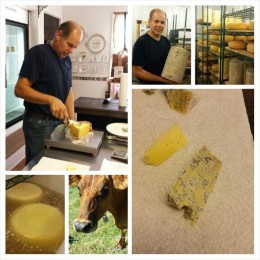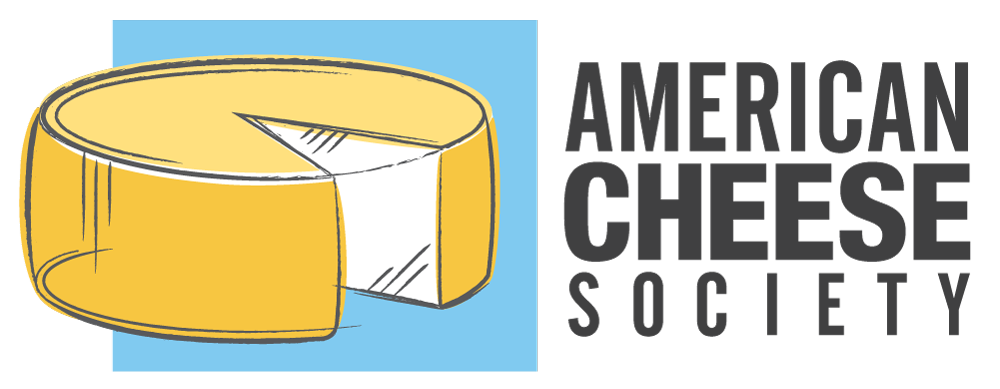By Marcella Wright, ACS CCP™
Recently I had the pleasure to visit Nature’s Harmony Farm in Northeast Georgia. Tim Young, Owner and Cheesemaker, in addition to a tour of his cheesemaking and aging facility, treated my husband and me to tastings of the four cheeses he makes. You can read more about the visit at my website.
Tim and his wife left behind a comfortable suburban life outside Atlanta after realizing they knew nothing about the source of the food they ate and fed their children. Instead of taking a few baby steps and joining a Community Supported Farm (CSA), they bought the farm, literally – more than one hundred acres outside the small town of Elberton, Georgia. And they became farmers. Today, just seven years later, they raise their own chickens, pigs, turkeys, lambs; grow their own fruits, nuts and vegetables. Tim keeps bees and he makes farmstead cheeses using the milk from his small Jersey herd. You can read about this journey in his book, “Accidental Farmers” (available on amazon) and if you’re interested in leading a more self-sufficient life, check out his new blog.
 Tim, with only one assistant, makes about fifteen-thousand pounds of cheese each year and that translates into very small batches. His cows are pasture-fed on the grass and flora indigenous to the area. He doesn’t plant annuals or perennials; he lets nature supply the food. In the early spring when the pasture is filled with native onions, he concentrates on making his award-winning blue cheese. The recipe better suits the herbaceous flavors the onion brings to the milk. Later in early summer his Georgia Gold and Fortsonia capture the flavors from the flowers growing in the field. Rather than bend his milk to suit his recipes, Tim adapts his recipes to fit his milk and showcase the diverse variations of the soil, the water and the grasses. That’s true artisan cheesemaking.
Tim, with only one assistant, makes about fifteen-thousand pounds of cheese each year and that translates into very small batches. His cows are pasture-fed on the grass and flora indigenous to the area. He doesn’t plant annuals or perennials; he lets nature supply the food. In the early spring when the pasture is filled with native onions, he concentrates on making his award-winning blue cheese. The recipe better suits the herbaceous flavors the onion brings to the milk. Later in early summer his Georgia Gold and Fortsonia capture the flavors from the flowers growing in the field. Rather than bend his milk to suit his recipes, Tim adapts his recipes to fit his milk and showcase the diverse variations of the soil, the water and the grasses. That’s true artisan cheesemaking.
All of Tim’s cheeses are made with raw Jersey milk from his herd and are aged a minimum of sixty days to meet federal regulations regarding raw milk cheeses.
The first cheese Tim shared with us was his new washed rind, Cherokee Rose, named after the Georgia State Flower. This cheese is aged sixty to ninety days. The one we tasted was at seventy days which Tim felt was the “sweet spot” for this batch. The mild funky aroma of a traditional washed rind was there, but subtle. The paste was tacky to the touch and creamy on the palate. The taste was sweet and nutty with a hint of sour on the finish.
The second cheese we tasted was his clouthbound cheddar, Georgia Gold. True to its name, the paste was a sunny yellow, almost gold, reflecting the beta carotene found in the farm’s grasses. Aged a minimum of six months, Georgia Gold reaches its peak at ten months and its flavor profile matures from a bright citrus into a mellow buttery taste as it ages. As mentioned above, Tim prefers to make this cheese during the early summer to embrace the flavors of the seasonal grasses. Georgia Gold won several awards in 2014 including Grand Prize at the Taste of Georgia Awards. And for a bit of trivia, President Jimmy Carter is a big fan of Georgia Gold.
After GG, we tasted his alpine-style cheese, Fortsonia, named after the community where the farm is located. The cheese had been aged about twelve months. While wonderful, Tim felt that Fortsonia hits its “sweet spot” in the eight to ten month range. Again reflecting the seasonality of the grass, the color was a daffodil yellow with a sweet and earthy aroma. The taste had a peppery sweetness with a fruity finish.
Elberton Blue was the last cheese we tasted. Tim referred to it as a “gateway blue”; for those reluctant to try blue cheese fearing its intensity, Elberton Blue is a milder introduction. The paste is closer to Stilton than a creamier blue like Rogue River. Again, the grass brings the beta carotene to the forefront with a mellow yellow colored paste with its beautiful blue veining. I tasted notes of chocolate and the cheese melted into a creamy, salty finish without overpowering. Of the four cheeses, Elberton Blue was my favorite.
Tim generously sent us home with wedges of Georgia Gold and Elberton Blue. I paired the Georgia Gold with Kelly’s Jelly’s Pine-a-peno which added a sweet spiciness to the nuttiness of the cheese. For the Elberton Blue I chose Pure Gallberry Honey from Blue Haven Bee Company in Canon, Georgia. The sweet gallberry contrasted well with the saltiness of the cheese.
If you have a chance to try these cheeses, you’ll be delighted. Nature’s Harmony cheeses are available in select specialty cheese shops throughout the Deep South and online. Many restaurants also feature Tim’s cheeses. The website lists several locations where you can purchase these cheeses.
Please visit my website where “It’s All About Cheese”.
Posted December 17, 2014
